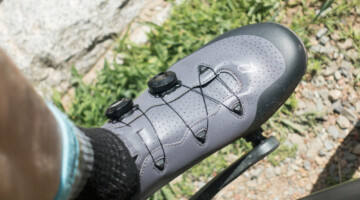
Katerina Nash dropped her chain in the final turn and lost her chance at a second consecutive bronze medal while Chainel-Lefevre took the medal. © Nathan Hofferber
Avoiding Situations Where Dropping the Chain is Common
Before we roll up our sleeves and head towards our work bench, the first item to assess is why our chain drops so frequently. The most likely answer to this is chaos. Cyclocross is a whirlwind of a sport where derailleurs get clogged with mud, bikes are flung onto our shoulders, and most of our components were designed with smooth road riding in mind. Even if your shop mechanic has the golden touch with your front derailleur, the well-adjusted derailleur cage won’t prevent your chain from dropping if the chain bounces from the bottom of your chainring. We’re not the only ones to have witnessed this either; more than a few commentators on our cowbell forum have noticed the chain bouncing off the chainring first.
There are a few situations that would cause a chain to bounce off the bottom of the chainring, causing the rest of the chain to drop. The first is more common with completely exhausted racers. When they are finished shouldering or carrying their bikes over a set of barriers, they don’t set their bike down, but practically just let go of the top tube, allowing their bike to slam against the muddy ground with their poor chain bouncing in every direction.
Think you’re safe with just a narrow/wide system? Think again. Last year during the Manitoba Grand Prix of Cyclocross in Winnipeg, we saw Jeremy Durrin lose his chain while riding on a SRAM CX1 system. The retention of narrow/wide chainrings is good, but not bulletproof.
In the second situation of chain drops from the bottom of the chainring, a rider is confidently roaring down technical terrain or attempting to bunny hop an obstacle to get their feet in the right position. Pedaling your feet backwards in these cases, or just as bad, attempting to shift gears, are two ways you will likely drop your chain.
In both of these situations, practicing techniques after a little high intensity training, when your heart is at elevated levels, might put your time to better use than attempting to perform a million adjustments on your bike. Reminding yourself to gently set down your bike or picking the smoothest lines might provide the ticket. But remember, even seasoned racers with their perfectly tuned bikes often catch a rough break every once and again, even pros like Jeremy Powers:
[vimeo 76890303 590 332]



























